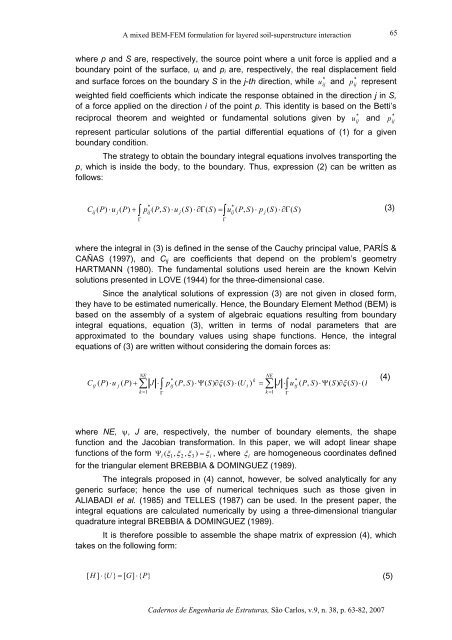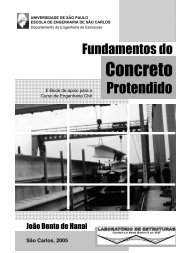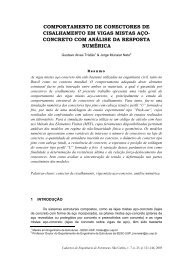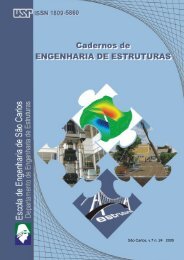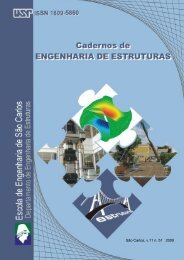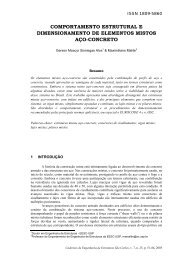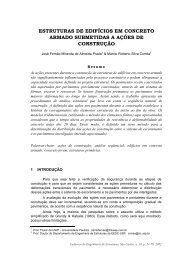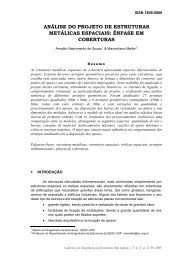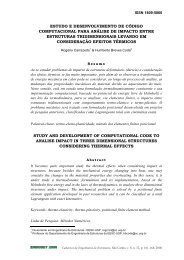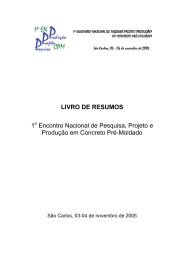download completo - SET - USP
download completo - SET - USP
download completo - SET - USP
Create successful ePaper yourself
Turn your PDF publications into a flip-book with our unique Google optimized e-Paper software.
A mixed BEM-FEM formulation for layered soil-superstructure interaction<br />
65<br />
where p and S are, respectively, the source point where a unit force is applied and a<br />
boundary point of the surface, u i and p i are, respectively, the real displacement field<br />
*<br />
*<br />
and surface forces on the boundary S in the j-th direction, while u ij and p ij represent<br />
weighted field coefficients which indicate the response obtained in the direction j in S,<br />
of a force applied on the direction i of the point p. This identity is based on the Betti’s<br />
reciprocal theorem and weighted or fundamental solutions given by u ij<br />
* and<br />
represent particular solutions of the partial differential equations of (1) for a given<br />
boundary condition.<br />
The strategy to obtain the boundary integral equations involves transporting the<br />
p, which is inside the body, to the boundary. Thus, expression (2) can be written as<br />
follows:<br />
p ij<br />
*<br />
*<br />
*<br />
C ( P)<br />
⋅ u ( P)<br />
+ p ( P,<br />
S)<br />
⋅ u ( S)<br />
⋅ ∂Γ(<br />
S)<br />
= u ( P,<br />
S)<br />
⋅ p ( S)<br />
⋅ ∂Γ(<br />
S)<br />
(3)<br />
ij<br />
j<br />
∫<br />
Γ<br />
ij<br />
j<br />
∫<br />
Γ<br />
ij<br />
j<br />
where the integral in (3) is defined in the sense of the Cauchy principal value, PARÍS &<br />
CAÑAS (1997), and C ij are coefficients that depend on the problem’s geometry<br />
HARTMANN (1980). The fundamental solutions used herein are the known Kelvin<br />
solutions presented in LOVE (1944) for the three-dimensional case.<br />
Since the analytical solutions of expression (3) are not given in closed form,<br />
they have to be estimated numerically. Hence, the Boundary Element Method (BEM) is<br />
based on the assembly of a system of algebraic equations resulting from boundary<br />
integral equations, equation (3), written in terms of nodal parameters that are<br />
approximated to the boundary values using shape functions. Hence, the integral<br />
equations of (3) are written without considering the domain forces as:<br />
ij<br />
j<br />
NE<br />
∑<br />
∫<br />
k = 1 Γ<br />
*<br />
ij<br />
C ( P)<br />
⋅u<br />
( P)<br />
+ J ⋅ p ( P,<br />
S)<br />
⋅ Ψ(<br />
S)<br />
∂ξ<br />
( S)<br />
⋅(<br />
U ) = J ⋅ u ( P,<br />
S)<br />
⋅ Ψ(<br />
S)<br />
∂ξ<br />
( S)<br />
⋅(<br />
P<br />
i<br />
k<br />
NE<br />
∑<br />
k = 1<br />
∫<br />
Γ<br />
*<br />
ij<br />
(4)<br />
where NE, ψ, J are, respectively, the number of boundary elements, the shape<br />
function and the Jacobian transformation. In this paper, we will adopt linear shape<br />
functions of the form Ψ i ( ξ 1 , ξ 2 , ξ 3 ) = ξ i , where ξ i are homogeneous coordinates defined<br />
for the triangular element BREBBIA & DOMINGUEZ (1989).<br />
The integrals proposed in (4) cannot, however, be solved analytically for any<br />
generic surface; hence the use of numerical techniques such as those given in<br />
ALIABADI et al. (1985) and TELLES (1987) can be used. In the present paper, the<br />
integral equations are calculated numerically by using a three-dimensional triangular<br />
quadrature integral BREBBIA & DOMINGUEZ (1989).<br />
It is therefore possible to assemble the shape matrix of expression (4), which<br />
takes on the following form:<br />
[ H ] ⋅ { U}<br />
= [ G]<br />
⋅{<br />
P}<br />
(5)<br />
Cadernos de Engenharia de Estruturas, São Carlos, v.9, n. 38, p. 63-82, 2007


